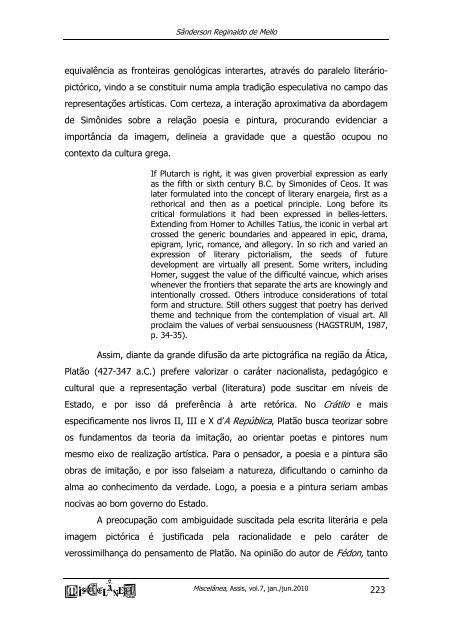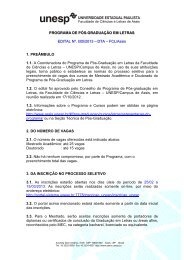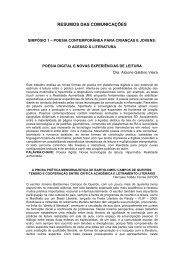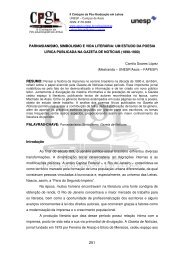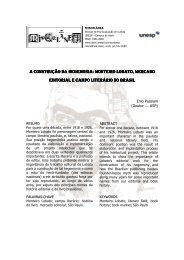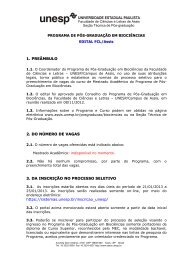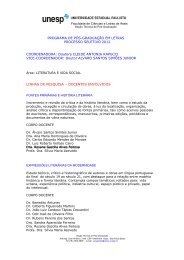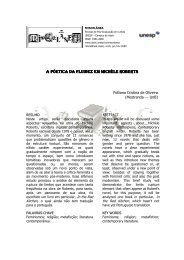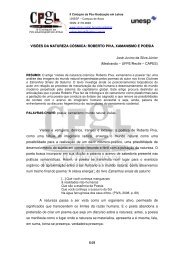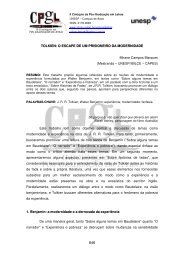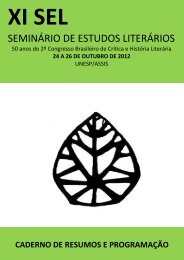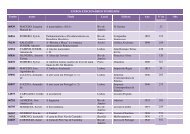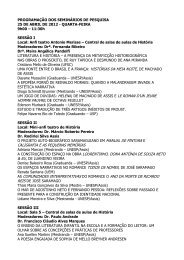O "ut pictura poesis" e as origens crÃticas da ... - UNESP-Assis
O "ut pictura poesis" e as origens crÃticas da ... - UNESP-Assis
O "ut pictura poesis" e as origens crÃticas da ... - UNESP-Assis
Create successful ePaper yourself
Turn your PDF publications into a flip-book with our unique Google optimized e-Paper software.
Sânderson Reginaldo de Melloequivalência <strong>as</strong> fronteir<strong>as</strong> genológic<strong>as</strong> interartes, através do paralelo literáriopictórico,vindo a se constituir numa ampla tradição especulativa no campo d<strong>as</strong>representações artístic<strong>as</strong>. Com certeza, a interação aproximativa <strong>da</strong> abor<strong>da</strong>gemde Simônides sobre a relação poesia e pintura, procurando evidenciar aimportância <strong>da</strong> imagem, delineia a gravi<strong>da</strong>de que a questão ocupou nocontexto <strong>da</strong> cultura grega.If Pl<strong>ut</strong>arch is right, it w<strong>as</strong> given proverbial expression <strong>as</strong> early<strong>as</strong> the fifth or sixth century B.C. by Simonides of Ceos. It w<strong>as</strong>later formulated into the concept of literary enargeia, first <strong>as</strong> arethorical and then <strong>as</strong> a poetical principle. Long before itscritical formulations it had been expressed in belles-letters.Extending from Homer to Achilles Tatius, the iconic in verbal artcrossed the generic boun<strong>da</strong>ries and appeared in epic, drama,epigram, lyric, romance, and allegory. In so rich and varied anexpression of literary pictorialism, the seeds of f<strong>ut</strong>uredevelopment are virtually all present. Some writers, includingHomer, suggest the value of the difficulté vaincue, which ariseswhenever the frontiers that separate the arts are knowingly andintentionally crossed. Others introduce considerations of totalform and structure. Still others suggest that poetry h<strong>as</strong> derivedtheme and technique from the contemplation of visual art. Allproclaim the values of verbal sensuousness (HAGSTRUM, 1987,p. 34-35).Assim, diante <strong>da</strong> grande difusão <strong>da</strong> arte pictográfica na região <strong>da</strong> Ática,Platão (427-347 a.C.) prefere valorizar o caráter nacionalista, pe<strong>da</strong>gógico ecultural que a representação verbal (literatura) pode suscitar em níveis deEstado, e por isso dá preferência à arte retórica. No Crátilo e maisespecificamente nos livros II, III e X d’A República, Platão busca teorizar sobreos fun<strong>da</strong>mentos <strong>da</strong> teoria <strong>da</strong> imitação, ao orientar poet<strong>as</strong> e pintores nummesmo eixo de realização artística. Para o pensador, a poesia e a pintura sãoobr<strong>as</strong> de imitação, e por isso falseiam a natureza, dificultando o caminho <strong>da</strong>alma ao conhecimento <strong>da</strong> ver<strong>da</strong>de. Logo, a poesia e a pintura seriam amb<strong>as</strong>nociv<strong>as</strong> ao bom governo do Estado.A preocupação com ambigui<strong>da</strong>de suscita<strong>da</strong> pela escrita literária e pelaimagem pictórica é justifica<strong>da</strong> pela racionali<strong>da</strong>de e pelo caráter deverossimilhança do pensamento de Platão. Na opinião do a<strong>ut</strong>or de Fédon, tantoMiscelânea, <strong>Assis</strong>, vol.7, jan./jun.2010 223


